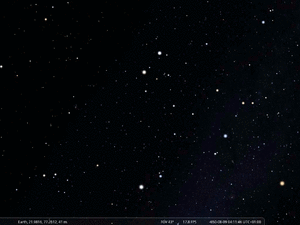Punarvasu: Difference between revisions
From All Skies Encyclopaedia
Punarvasu
No edit summary |
No edit summary |
||
| Line 16: | Line 16: | ||
=== Origin of Constellation === |
=== Origin of Constellation === |
||
The name of the constellations is grammatically a dual, so it points to two similar stars/ asterisms. This way, it equals the idea of the Greco-Roman and Mesopotamian Twin-constellation where two bright stars head two similar, parallel chains of stars. |
The name of the constellations is grammatically a dual, so it points to two similar stars/ asterisms. This way, it equals the idea of the Greco-Roman and Mesopotamian Twin-constellation where two bright stars head two similar, parallel chains of stars. |
||
4 stars: α, β Geminorum are certain; the other two might be ε, ζ Gem |
|||
=== Transfer and Transformation of the Constellation === |
=== Transfer and Transformation of the Constellation === |
||
Latest revision as of 06:55, 14 October 2025
Punarvasu (पुनर्वसु), "the twin-restorers of goods", is an Indian name, used by the Indian Vedic tradition. Most of these names are roughly 3000 years old. They pre-date Hinduism but were taken over by it.
Etymology and History
Name Variants
- Punarvasu (the two restorers),
- Yamakau ("the two chariots")
- Aditerbha
Origin of Constellation
The name of the constellations is grammatically a dual, so it points to two similar stars/ asterisms. This way, it equals the idea of the Greco-Roman and Mesopotamian Twin-constellation where two bright stars head two similar, parallel chains of stars.
4 stars: α, β Geminorum are certain; the other two might be ε, ζ Gem
Transfer and Transformation of the Constellation
Mythology
mnemonic tales and cultural significance
Weblinks
References
- References (general)







